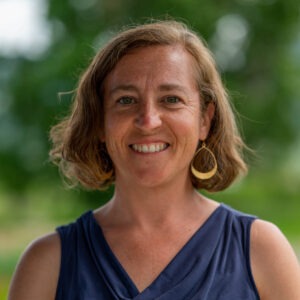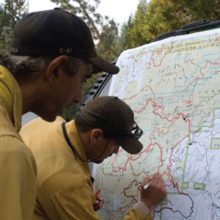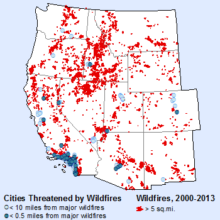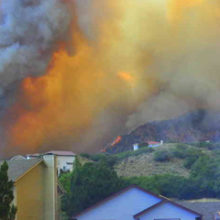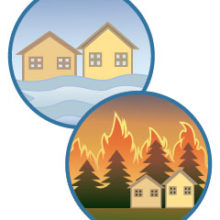Hurricane Harvey made clear the two trends on a collision course in America: cities are growing in population and expanse while natural disasters such as wildfires, floods, and severe weather are increasing in size and frequency. Better land use planning for growing cities can reduce the consequences of natural disasters.
Cities of all sizes in nearly all places are at risk of disasters, as we’ve seen with recent events like Hurricane Harvey, the La Tuna wildfire in Los Angeles, and tornadoes in Moore, Oklahoma. We are living in an era of megafires, megastorms, and megadroughts. No place is immune, and as our cities grow, the consequences grow, too.
Houston has been primed for disaster since it was constructed in the 1830s on the edge of a bayou. Famous for its lack of land use planning and regulation, the city’s limitless growth sometimes has been viewed as an American success story, helping generate a community with a resilient economy and one of the most diverse populations in the country.
But during the last several decades, Houston has realized that paving wetlands and allowing construction near bayous and stream channels without restraint placed people and the region’s economy in the path of danger.
While some argue that the lack of building regulations allowed for the development of affordable housing and put the American dream within reach for many Houstonians, today the cost of those land use decisions disproportionately affects Houston’s most vulnerable people: the poor, the elderly, the young, the disabled, and minorities. Many of Houston’s residents did not have flood insurance, cannot afford to rebuild, and watched the entirety of their life’s work wash away.
 Fires and floods will inevitably keep coming, but we can broaden our approaches to make our communities safer. Land use planning is one tool that can help reduce the consequences of disaster. Combining the best available science about risk with the best land use planning strategies, we can deploy smart tactics to determine where we should (and should not) build, what building materials will help make us safer, and the infrastructure that will help our response when disasters do strike.
Fires and floods will inevitably keep coming, but we can broaden our approaches to make our communities safer. Land use planning is one tool that can help reduce the consequences of disaster. Combining the best available science about risk with the best land use planning strategies, we can deploy smart tactics to determine where we should (and should not) build, what building materials will help make us safer, and the infrastructure that will help our response when disasters do strike.
The expense of new regulation may have initial consequences, but we should consider the costs in the context of disasters of increasing scale and frequency. Losses from Harvey are estimated in the $50-350 billion range, a cost that all taxpayers will shoulder.
Similarly, wildfire costs burden state and federal budgets, diverting resources from other needs. At an estimated rate of $1.5 million per day in Montana this year alone, wildfire costs take away from many other state services.
But initial disaster costs are just the tip of the iceberg. Long-term social and environmental costs affect communities for years, including lost business revenue, depreciating property values, strained infrastructure, water quality challenges, and adverse mental and physical health issues.
Many cities are particularly vulnerable to wildfire, and in the West 84 percent of the most fire-prone lands are undeveloped. We have an opportunity now to get ahead of growth trends and institute land use planning strategies that mitigate risk.
 Across the country, many communities are taking proactive steps to specifically address how land use planning can make their communities safer. The Community Planning Assistance for Wildfire (CPAW) program has provided land use planning recommendations, risk assessments, and research to 18 cities and counties. Funded by the U.S. Forest Service, the LOR Foundation, and other private foundations, the services come at no cost to the community. CPAW currently is accepting applications for new communities.
Across the country, many communities are taking proactive steps to specifically address how land use planning can make their communities safer. The Community Planning Assistance for Wildfire (CPAW) program has provided land use planning recommendations, risk assessments, and research to 18 cities and counties. Funded by the U.S. Forest Service, the LOR Foundation, and other private foundations, the services come at no cost to the community. CPAW currently is accepting applications for new communities.
Hurricane Harvey offers a simple lesson: No location is immune to the risks of the natural environment. From flooding to earthquake, tornado to wildfire, we live with risk from coast to coast. In many places, this risk is amplified by the converging forces of climate change and growing populations. If we are going to live safely with increasing risk in our ever-expanding cities, we should proactively, thoughtfully plan our growth.
